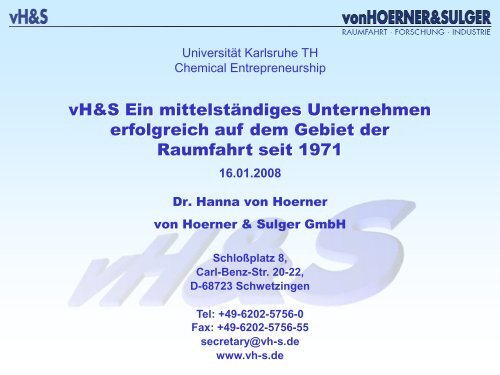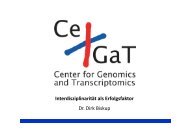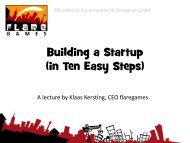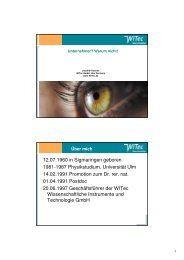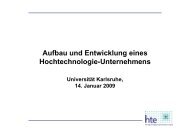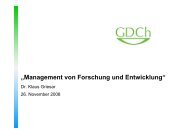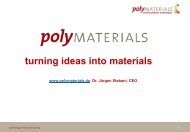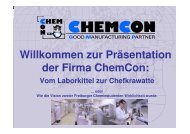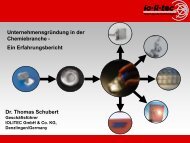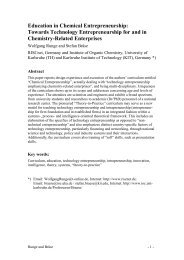von Hoerner & Sulger GmbH - KIT - Technology Entrepreneurship
von Hoerner & Sulger GmbH - KIT - Technology Entrepreneurship
von Hoerner & Sulger GmbH - KIT - Technology Entrepreneurship
Sie wollen auch ein ePaper? Erhöhen Sie die Reichweite Ihrer Titel.
YUMPU macht aus Druck-PDFs automatisch weboptimierte ePaper, die Google liebt.
Universität Karlsruhe TH<br />
Chemical <strong>Entrepreneurship</strong><br />
vH&S Ein mittelständiges Unternehmen<br />
erfolgreich auf dem Gebiet der<br />
Raumfahrt seit 1971<br />
16.01.2008<br />
Dr. Hanna <strong>von</strong> <strong>Hoerner</strong><br />
<strong>von</strong> <strong>Hoerner</strong> & <strong>Sulger</strong> <strong>GmbH</strong><br />
Schloßplatz 8,<br />
Carl-Benz-Str. 20-22,<br />
D-68723 Schwetzingen<br />
Tel: +49-6202-5756-0<br />
Fax: +49-6202-5756-55<br />
secretary@vh-s.de<br />
www.vh-s.de
Firmenorganisation<br />
Dr.-Ing. H. Henkel<br />
Rocket- & Space-<br />
Instrumentation<br />
Scientific Analysis<br />
Instrument Concepts<br />
Frontend Design<br />
Converter <strong>Technology</strong><br />
Instrument AIV<br />
Ground Support Equipment<br />
Industrial Developments<br />
<strong>von</strong> <strong>Hoerner</strong> & <strong>Sulger</strong> <strong>GmbH</strong><br />
Schloßplatz 8, D – 68723 Schwetzingen, Germany<br />
Dr. Hanna <strong>von</strong> <strong>Hoerner</strong><br />
Dr. Hartmut Henkel Dr. Josef Dalcolmo<br />
Directorate<br />
B. Hürstel<br />
Administration, Payroll<br />
& Contracts<br />
D. Tschano<br />
Accounting<br />
Dr. J. Dalcolmo<br />
Space Sensors<br />
System Analysis<br />
Control and Data Handling<br />
Imaging Optics<br />
Prototyping<br />
System Assembly and Testing<br />
Plant Management<br />
P. Müller<br />
Front Desk<br />
Dipl.-Ing. G. Krein<br />
PA & QA<br />
A. Koch<br />
Space Electronics<br />
& Laser Systems<br />
Mass Spectrometer D&D<br />
HV Converters<br />
Power Converters<br />
Laser <strong>Technology</strong><br />
Analogue Electronics<br />
Dr. Christopher Lee<br />
Robotic Systems<br />
Mobile Robotic Systems<br />
Mechanisms<br />
Software<br />
Digital Electronics<br />
Chemical <strong>Entrepreneurship</strong>, 16.01.2007 , Folie 2
Mitarbeiter und Ausstattung<br />
Gründung der Firma vH&S in 1971<br />
Angestellte: ~ 20<br />
Geschäftsräume: Schwetzingen<br />
Schloßplatz:<br />
Management und Entwicklung<br />
Industriegebiet:<br />
Fertigung und Reinräume<br />
<strong>von</strong> <strong>Hoerner</strong> & <strong>Sulger</strong> <strong>GmbH</strong><br />
Schloßplatz 8, D – 68723 Schwetzingen, Germany<br />
Chemical <strong>Entrepreneurship</strong>, 16.01.2007 , Folie 3
Mitarbeiter und Ausstattung<br />
Direktorat: Dr. Hanna <strong>von</strong> <strong>Hoerner</strong>,<br />
Dr. Hartmut Henkel, Dr. Josef<br />
Dalcolmo<br />
Technisches Management:<br />
Dr. Hartmut Henkel, Dr. Josef<br />
Dalcolmo<br />
Einrichtungen für die Entwicklung<br />
<strong>von</strong> Elektronik, Mechatronik und<br />
flugqualifizierter Hardware<br />
Reinraum, Integrationsräume und<br />
Testanlagen<br />
Hochqualifizierte Mitarbeiter<br />
Ausrüstung für modernste Elektronikund<br />
Sensorentwicklung,<br />
Simulationen und Datenverarbeitung<br />
<strong>von</strong> <strong>Hoerner</strong> & <strong>Sulger</strong> <strong>GmbH</strong><br />
Schloßplatz 8, D – 68723 Schwetzingen, Germany<br />
Chemical <strong>Entrepreneurship</strong>, 16.01.2007 , Folie 4
Business Segmente<br />
<strong>von</strong> <strong>Hoerner</strong> & <strong>Sulger</strong> <strong>GmbH</strong><br />
Schloßplatz 8, D – 68723 Schwetzingen, Germany<br />
Raumfahrt<br />
Industrie<br />
Entwicklungen<br />
Systeme für<br />
Industrieanwendungen<br />
Medizin<br />
Technik<br />
Chemical <strong>Entrepreneurship</strong>, 16.01.2007 , Folie 5
vH&S Business-Sektor Raumfahrt<br />
Kameras/<br />
Sensoren<br />
Ballistische<br />
Raketen<br />
Experimente<br />
<strong>von</strong> <strong>Hoerner</strong> & <strong>Sulger</strong> <strong>GmbH</strong><br />
Schloßplatz 8, D – 68723 Schwetzingen, Germany<br />
Robotik<br />
Rover<br />
System Studien<br />
Raumfahrt<br />
Experimente<br />
In-Situ<br />
Analysen<br />
Industrie<br />
Anwendungen<br />
Spektrometer<br />
Chemical <strong>Entrepreneurship</strong>, 16.01.2007 , Folie 6
Beispiel vH&S als erfolgreiches KMU im Weltraumsektor<br />
Fertigung und<br />
Entwicklung für<br />
Institute<br />
seit 1971<br />
Fertigung und<br />
Entwicklung für<br />
Industrie<br />
<strong>von</strong> <strong>Hoerner</strong> & <strong>Sulger</strong> <strong>GmbH</strong><br />
Schloßplatz 8, D – 68723 Schwetzingen, Germany<br />
Bau <strong>von</strong><br />
flugqualifizierten<br />
Weltraumexperimenten<br />
u. Raketenexperimenten<br />
Entwicklung <strong>von</strong><br />
Prozesssteuerungen u.<br />
Kontrollelementen<br />
76 Raumfahrtprojekte<br />
(da<strong>von</strong> 16 Extraterrestrische<br />
Experimente und 34<br />
Raketenexperimente)<br />
Weltmarktführer:<br />
Kometenstaubexperimente<br />
Europaführend:<br />
weltraumtaugliche Rover<br />
heute<br />
vH&S Statistik: bis<br />
heute alle Instrumente<br />
erfolgreich<br />
Spezialist für<br />
Sonderlösungen der<br />
Prozessautomation<br />
104 Projekte für die Industrie<br />
und die Medizintechnik<br />
Chemical <strong>Entrepreneurship</strong>, 16.01.2007 , Folie 7
KMUs in Deutschland allgemein<br />
Zahlen und Fakten <strong>von</strong> KMUs in Deutschland<br />
• 70% aller Arbeitsplätze in Deutschland<br />
• 80% aller Ausbildungsplätze<br />
• 49% der Bruttowertschöpfung<br />
• Über den Zeitraum <strong>von</strong> 2003-2005 wurden:<br />
<strong>von</strong> <strong>Hoerner</strong> & <strong>Sulger</strong> <strong>GmbH</strong><br />
Schloßplatz 8, D – 68723 Schwetzingen, Germany<br />
+ 400.000 neue Arbeitsplätze geschaffen durch KMU„s<br />
• Im gleichen Zeitraum Abbau <strong>von</strong><br />
- 120.000 Arbeitsplätze durch Großkonzerne<br />
Chemical <strong>Entrepreneurship</strong>, 16.01.2007 , Folie 8
Raumfahrt-KMUs in Deutschland<br />
Zahlen und Fakten <strong>von</strong> Luft- und Raumfahrt KMUs in Deutschland<br />
Umsatz und Beschäftigte in Prozent<br />
• Anzahl der Beschäftigten<br />
• KMUs: 5539<br />
• Große Unternehmen: 57391<br />
• Umsatz (Mio. Euro)<br />
• KMUs: 1687<br />
• Große Unternehmen: 12890<br />
120,0<br />
100,0<br />
80,0<br />
60,0<br />
40,0<br />
20,0<br />
0,0<br />
<strong>von</strong> <strong>Hoerner</strong> & <strong>Sulger</strong> <strong>GmbH</strong><br />
Schloßplatz 8, D – 68723 Schwetzingen, Germany<br />
Beschäftigte und Umsatz - Vergleich <strong>von</strong> KMUs und<br />
Großunternehmen in der Raumfahrt<br />
8,8 11,6<br />
91,2 88,4<br />
Beschäftigte Umsatz<br />
KMUs<br />
Große<br />
Quelle:<br />
BDLI Statistiken<br />
Luft- und<br />
Raumfahrt<br />
2004 / 2005<br />
Chemical <strong>Entrepreneurship</strong>, 16.01.2007 , Folie 9
Problembereiche der Raumfahrt KMUs<br />
Was muss man tun, damit KMUs keine ‚endangered species‘ werden<br />
• Software / Ausrüstung bedingen hohe Investitionskosten � Unterstützung<br />
• Wahrung des Knowhows bei „Durststrecken“<br />
• Für ausreichend Kontinuität sorgen, da weniger Reserven bei KMUs vorhanden sind<br />
• Wachsende Konzentration auf wenige große Unternehmen vermeiden<br />
• Stetig steigenden bürokratischen Hindernissen entgegenwirken<br />
• Verhindern <strong>von</strong> ungenügenden Budgets in ESA Entwicklungsprojekten (TRP projects)<br />
� Von denen nur 11% an dt. KMUs vergeben werden<br />
• Nationales Raumfahrt Budget ist nicht ausreichend � Erhöhen!<br />
� nur 22% werden an KMUs vergeben <strong>von</strong> 80Mio. Industrie-Aufträgen<br />
• Bekämpfung des mangelnden Fachkräfte-Angebots<br />
• Verbesserung der Situation für Unterauftragnehmer: Subkontrakte der großen<br />
Unternehmen enthalten oft anspruchslose Inhalte<br />
• Stützung der Wettbewerbsfähigkeit durch rechtzeitige Förderung technologischer<br />
Vorentwicklungen<br />
• Anpassung der Budgets:<br />
• EU: 15€ / Kopf für die Raumfahrt<br />
USA: 110€ / Kopf für die Raumfahrt<br />
Frankreichs Raumfahrt Budget ist 3x so hoch wie das <strong>von</strong> Deutschland<br />
Italiens Raumfahrt Budget ist 2x so hoch wie das <strong>von</strong> Deutschland<br />
<strong>von</strong> <strong>Hoerner</strong> & <strong>Sulger</strong> <strong>GmbH</strong><br />
Schloßplatz 8, D – 68723 Schwetzingen, Germany<br />
Chemical <strong>Entrepreneurship</strong>, 16.01.2007 , Folie 10
Was zeichnet KMUs im Raumfahrt Sektor besonders aus?<br />
Wild 2<br />
Innovative Kraft: Weltmarktführer bei Fluginstrumenten zur<br />
Analyse <strong>von</strong> Kometenstaub<br />
CIDA - Cometary and Interstellar Dust Analyzer<br />
„in-situ“ Analysen der Zusammensetzung<br />
<strong>von</strong> interstellaren und<br />
Kometenstaubpartikeln<br />
Entwickelt im Auftrag der DARA/BMBF und<br />
des Max-Planck-Institut für<br />
Extraterrestrische Forschung in Garching,<br />
für den Flug auf der NASA STARDUST<br />
Mission; Start: 07 Februar 1999<br />
CIDA 2 im Auftrag <strong>von</strong> JHU/APL für die<br />
NASA Mission CONTOUR;<br />
Start: 01 Juli 2002<br />
COSIMA - Cometary Secondary Ion<br />
Mass Analyser<br />
SIMS Kometen Spektrometer für „in-situ“<br />
Analysen der Zusammensetzung <strong>von</strong><br />
Staubpartikel des Kometen<br />
67P/Churyumov-Gerasimenko<br />
Entwickelt für das Max-Planck-Institut für<br />
Extraterrestrische Forschung in Garching,<br />
für den Flug auf der ESA ROSETTA<br />
Mission; Start: 02. März 2004<br />
<strong>von</strong> <strong>Hoerner</strong> & <strong>Sulger</strong> <strong>GmbH</strong><br />
Schloßplatz 8, D – 68723 Schwetzingen, Germany<br />
Chemical <strong>Entrepreneurship</strong>, 16.01.2007 , Folie 11
Was zeichnet KMUs im Raumfahrt Sektor besonders aus?<br />
Hohe Motivation: vH&S ist innerhalb Europas der einzige<br />
Anbieter für Rover zur Planetenerkundung<br />
NANOKHOD – Rover für wissenschaftliche Exploration<br />
• Entwicklung seit 1993 - jetzt<br />
• ”In-situ” geochemische Analysen auf Planetenoberflächen<br />
> Nutzlast: GIPF - Geochemistry Instrument Package Facility<br />
• Entwicklung für die Merkur Nachtseite: Oberflächentemperatur -183°C,<br />
Hochvakuum, Regolith Oberfläche, Landeschock <strong>von</strong> 200g über 20ms<br />
• Autonimiekonzepte in Verbindung mit dem Lander<br />
SOLERO – Minirover für regionale wissenschaftliche Exploration<br />
• Innovatives passives Chassis Konzept mit einzigartigen<br />
Kletterfähigkeiten für regionale Mobiltät auf dem Mars<br />
• Rhombus Konfiguration: Ein gefedertes Frontrad, ein festmontiertes<br />
Hinterrad und je zwei Räder an den seitlichen Bogies<br />
• Breadboard Entwicklung im Auftrag der ESA.<br />
• Nutzlast: GIPF - Geochemistry Instrument Package Facility<br />
ExoMars CM – Breadboard des ExoMars Rover Chassis<br />
• ExoMars CM entwickelt für die ESA Cornerstone Mission Aurora<br />
• ExoMars Rover Nutzlast: Exobiologische and Geochemische<br />
Nutzlastpakete (Pasteur)<br />
• Chassis CM wurde nach ExoMars Phase A Anforderungen gebaut<br />
• Breadboard Entwicklung im Auftrag <strong>von</strong> EADS Astrium UK.<br />
• Bau des Breadboards für Funktionstests, zur Verifikation <strong>von</strong> Software<br />
Modellen und für motion control/navigation-Software Tests.<br />
<strong>von</strong> <strong>Hoerner</strong> & <strong>Sulger</strong> <strong>GmbH</strong><br />
Schloßplatz 8, D – 68723 Schwetzingen, Germany<br />
Chemical <strong>Entrepreneurship</strong>, 16.01.2007 , Folie 12
<strong>von</strong> <strong>Hoerner</strong> & <strong>Sulger</strong> <strong>GmbH</strong><br />
Schloßplatz 8, D – 68723 Schwetzingen, Germany<br />
Film: Rover-Video-1min_version2.wmv<br />
Chemical <strong>Entrepreneurship</strong>, 16.01.2007 , Folie 13
Was zeichnet KMUs im Raumfahrt Sektor besonders aus?<br />
Flexibilität: Einzigartiger Einsatz <strong>von</strong> Weltraumerfahrungen zur<br />
Lösung <strong>von</strong> Industrieproblemen<br />
Anwendung für die Verpackungsindustrie<br />
• Sensor zur Bestimmung der Spleißstelle<br />
eines Polyethylen-Bandes (PE-Tape) mit<br />
Hilfe eines kapazitiven Verfahrens<br />
• Sensorprinzip nutzt die Veränderung der<br />
relativen Dielektrizitätskonstante, des<br />
Mediums zwischen zwei Kondensatorplatten<br />
• Hochempfindliches HF-Brücken-Verfahren<br />
• Konzipiert für den Einsatz in einer<br />
Produktionsstraße<br />
• Kompakter und sowohl elektrisch als auch<br />
mechanisch robuster Aufbau - wenig<br />
schmutzanfälliges Funktionsprinzip<br />
• Hochentwickelte Elektronik für die<br />
Auswertung der Sensorsignale<br />
<strong>von</strong> <strong>Hoerner</strong> & <strong>Sulger</strong> <strong>GmbH</strong><br />
Schloßplatz 8, D – 68723 Schwetzingen, Germany<br />
Chemical <strong>Entrepreneurship</strong>, 16.01.2007 , Folie 14
Was zeichnet KMUs im Raumfahrt Sektor besonders aus?<br />
Risikobereitschaft: Kein Weltkonzern ist damals das Wagnis<br />
dieses Projekts eingegangen<br />
PUMA - Particle Impact Dust Analyser<br />
• Staub-Impakt-Massenspektrometer PUMA<br />
1/2 flog auf der sowjetischen Sonde VeGa,<br />
die für den Vorbeiflug an der Venus und für<br />
die Beobachtung des Halley-Kometen<br />
konzipiert war<br />
• vH&S war für PUMA prime contractor des<br />
Max-Planck-Institutes für Kernphysik<br />
Heidelberg und SA Paris (1982-85).<br />
• Das Flugzeitmassenspektrometer dient der<br />
Bestimmung der chemischen<br />
Zusammensetzung, sowie der Masse des<br />
Staubs<br />
• Messung <strong>von</strong> 12 Spektren pro Sekunde<br />
• PUMA wog 19 kg und hatte einen<br />
Energieverbrauch <strong>von</strong> 31 Watt<br />
• Start: 15. + 21. Dezember 1984<br />
<strong>von</strong> <strong>Hoerner</strong> & <strong>Sulger</strong> <strong>GmbH</strong><br />
Schloßplatz 8, D – 68723 Schwetzingen, Germany<br />
Chemical <strong>Entrepreneurship</strong>, 16.01.2007 , Folie 15
Was zeichnet KMUs im Raumfahrt Sektor besonders aus?<br />
Wenig Administration � schnelle effektive Lösungen:<br />
mehr als 30 wissenschaftliche Experimente auf ballistischen Raketen<br />
Total<br />
• Piraniröhren-Sonde zur Messung der<br />
Atmosphärendichte<br />
• Als Hauptauftragnehmer der Universität Bonn<br />
(1986-89).<br />
• System zur Erforschung der mittleren und<br />
oberen Erdatmosphäre<br />
Ecoma<br />
• Ecoma (2003-07) besteht aus einem Set <strong>von</strong><br />
vier Instrumenten für das Leibniz-Institute für<br />
Atmosphären Physik (IAP) in Kühlungsborn.<br />
• Mit einem neuartigem Detektor für ballistische<br />
Raketen werden Meteoritenstaubpartikeln im<br />
Nanometer Bereich gemessen<br />
• Die Partikel werden durch Bestrahlung mittels<br />
des UV-Lichts einer Xenon Blitzlampe<br />
ionisiert und mit einem sensiblen<br />
Elektrometer detektiert<br />
<strong>von</strong> <strong>Hoerner</strong> & <strong>Sulger</strong> <strong>GmbH</strong><br />
Schloßplatz 8, D – 68723 Schwetzingen, Germany<br />
Chemical <strong>Entrepreneurship</strong>, 16.01.2007 , Folie 16
Was zeichnet KMUs im Raumfahrt Sektor besonders aus?<br />
Hohe Qualität durch Gesamtüberblick und Kontrolle bei<br />
Projekten bis 10M€ Auftragssumme:<br />
bei höchsten Anforderungen an Präzision unter Reinraumbedingungen<br />
Lasco - Soho<br />
• Coronograph LASCO/C1 auf SOHO als<br />
Hauptauftragnehmer des MPAe Lindau (1991-95)<br />
• Untersuchungen der Sonnenkorona im Bereich<br />
<strong>von</strong> 1,1 - 32 Sonnenradien<br />
• Wie wird die Korona geheizt?<br />
• Wie und wo entsteht der Sonnenwind?<br />
• Wie kommt es zu explosiven Ausbrüchen<br />
und wie laufen sie im einzelnen ab?<br />
• Vom Lagrange Punkt Sonne/Erde aus macht<br />
LASCO synoptische Bilder - ähnlich einer<br />
Sonnenfinsternis - im Spektralbereich des<br />
sichtbaren Lichts<br />
• Der Instrumententeil C1 bestimmt die globale<br />
Verteilung wichtiger Plasmagrößen mittels<br />
spektroskopischer Techniken für den innersten<br />
und hellsten Messbereich <strong>von</strong> 1,1 bis 3<br />
Sonnenradien<br />
Start: 02. Dezember 1995<br />
<strong>von</strong> <strong>Hoerner</strong> & <strong>Sulger</strong> <strong>GmbH</strong><br />
Schloßplatz 8, D – 68723 Schwetzingen, Germany<br />
Chemical <strong>Entrepreneurship</strong>, 16.01.2007 , Folie 17
3x<br />
6x<br />
Was war hilfreich / notwendig für den Erfolg eines KMUs?<br />
2x<br />
4x<br />
2x<br />
Ma<br />
I.<br />
o<br />
.<br />
<strong>von</strong> <strong>Hoerner</strong> & <strong>Sulger</strong> <strong>GmbH</strong><br />
Schloßplatz 8, D – 68723 Schwetzingen, Germany<br />
F<br />
• Enger Kontakt zu Forschungsinstituten und<br />
Universitäten im In- und Ausland<br />
• Bereitschaft auch zu “unkonventionellen” Lösungen<br />
� z.B. HICoPS<br />
• Hohe Risikobereitschaft bei der Anwendung neuer<br />
Technologien<br />
� z.B. BELA<br />
• Einbindung eigener Facilities der Auftraggeber zur<br />
Kostenreduktion<br />
Chemical <strong>Entrepreneurship</strong>, 16.01.2007 , Folie 18
Was war hilfreich / notwendig für den Erfolg eines KMUs?<br />
Dr.-Ing. H. Henkel<br />
Space Systems &<br />
Industrial Instrumentation<br />
Scientific Analysis<br />
Instrument Concepts<br />
Frontend Design<br />
Converter <strong>Technology</strong><br />
Instrument AIV<br />
Ground Support Equipment<br />
Industrial Developments<br />
B. Hürstel<br />
Administration, Payroll<br />
& Contracts<br />
D. Tschano<br />
Accounting<br />
Dr. J. Dalcolmo<br />
Space Instrumentation<br />
System Analysis<br />
Control and Data Handling<br />
Imaging Optics<br />
Prototyping<br />
System Assembly and Testing<br />
Plant Management<br />
Dr. Hanna <strong>von</strong> <strong>Hoerner</strong><br />
Executive and Technical<br />
Director<br />
P. Müller<br />
Front Desk<br />
G. Krein<br />
PA & QA<br />
A. Koch<br />
Space Instrumentation<br />
Mass Spectrometer D&D<br />
HV Converters<br />
Power Converters<br />
Laser <strong>Technology</strong><br />
Analogue Electronics<br />
Dr. Christopher Lee<br />
Robotics<br />
Mobile Robotic Systems<br />
Mechanisms<br />
Software<br />
Digital Electronics<br />
<strong>von</strong> <strong>Hoerner</strong> & <strong>Sulger</strong> <strong>GmbH</strong><br />
Schloßplatz 8, D – 68723 Schwetzingen, Germany<br />
• Minimum an administrativem Aufwand durch engen<br />
Kontakt zwischen Geschäftsleitung und Projekt<br />
Management daher auch günstige Preisgestaltung<br />
• Großer Anteil an nationalen Raumfahrtprojekten, da<br />
keine große Administration notwendig ist, dafür ein<br />
direkter Kontakt zu den Forschungsinstituten besteht<br />
• Ausbildung der Konkurrenzfähigkeit bei ESA-Projekten<br />
• Offener und durchschaubarer Kontakt zum<br />
Auftraggeber während der gesamten Projektlaufzeit<br />
• Großes Vertrauen der Auftraggeber bei neuartigen oder<br />
schwierigen Projekten<br />
Chemical <strong>Entrepreneurship</strong>, 16.01.2007 , Folie 19
Forschungsprojekte im Detail<br />
CONE / MIDAS - Combined Sensor for Neutrals and Electrons<br />
• Mission: Rocket experiment with ionisation gauge for in-situ<br />
measurement of fine scale neutral density fluctuations in the<br />
upper atmosphere (e.g. turbulence).<br />
• Developed for Institut für Atmosphärenphysik (IAP). The<br />
Instrument is reusable and a set of four experiments are in<br />
use since summer 2000.<br />
• Instrument specifications<br />
Pressure range: 1 ... 10-4 mbar<br />
Analysing range: 60 ... 120 km<br />
Instrument mass: 3.5 kg<br />
Power consumption: 15 W<br />
Instrument Development:<br />
<strong>von</strong> <strong>Hoerner</strong> & <strong>Sulger</strong> <strong>GmbH</strong><br />
Schloßplatz 8, 68723 Schwetzingen, Germany<br />
Phone: +49-6202-5756-0, Fax: +49-6202-5756-55<br />
E-Mail: secretary@vh-s.de Web: www.vh-s.de<br />
Principal Investigator:<br />
Prof. Dr. Franz-Josef Lübken<br />
Leibniz- Institut für Atmosphärenphysik e.V.<br />
an der Universität Rostock<br />
Schlossstraße 6, 18225 Kühlungsborn Germany<br />
Phone: +49 38293 68100<br />
E-Mail: luebken@iap-kborn.de<br />
<strong>von</strong> <strong>Hoerner</strong> & <strong>Sulger</strong> <strong>GmbH</strong><br />
Schloßplatz 8, D – 68723 Schwetzingen, Germany<br />
Chemical <strong>Entrepreneurship</strong>, 16.01.2007 , Folie 20
Forschungsprojekte im Detail<br />
LAD/TWINS – Lyman-Alpha Detector<br />
• Mission: Measurement of Lyman-Alpha radiation in<br />
the earth magnetosphere. Two channeltrondetectors<br />
with filters and collimator baffles, pulsediscriminator<br />
amplifiers, and HV-supply.<br />
• German contribution to US TWINS mission.<br />
Two launches: First 2004<br />
• Instrument specifications<br />
Power consumption: 150 mW<br />
Mass: 980 g<br />
Instrument Development:<br />
<strong>von</strong> <strong>Hoerner</strong> & <strong>Sulger</strong> <strong>GmbH</strong><br />
Schloßplatz 8, 68723 Schwetzingen, Germany<br />
Phone: +49-6202-5756-0, Fax: +49-6202-5756-55<br />
E-Mail: secretary@vh-s.de Web: www.vh-s.de<br />
Principal Investigator:<br />
Prof. Dr. Hans J. Fahr<br />
Institut für Astrophysik und Extraterrestrische<br />
Forschung der Universität Bonn<br />
Auf dem Hügel 71 D-53121 Bonn<br />
<strong>von</strong> <strong>Hoerner</strong> & <strong>Sulger</strong> <strong>GmbH</strong><br />
Schloßplatz 8, D – 68723 Schwetzingen, Germany<br />
Chemical <strong>Entrepreneurship</strong>, 16.01.2007 , Folie 21
Forschungsprojekte im Detail<br />
GIPF-Geochemistry Instrument Package Facility<br />
•”In-situ” geochemical analysis of various<br />
samples on a planetary surface<br />
•Highly integrated instrument electronics:<br />
Minimisation of power, vol & mass<br />
Single Interface to Rover<br />
Common state of the art digital pulse<br />
shaping<br />
•Microscopic Camera:<br />
Far-field & microscopic modes<br />
Fine tuneable focus mechanism<br />
RGB + IR illumination<br />
•Moessbauer Spectrometer:<br />
mineralogical analysis of iron containing<br />
rock and soil, determination of oxidation<br />
state<br />
•APX spectrometer: analysis using á & xray<br />
excitation of elements with low and<br />
high atomic numbers<br />
•Mass: 800g.<br />
Volume: 50 x 68 x 147 mm<br />
About the company:<br />
<strong>von</strong> <strong>Hoerner</strong> & <strong>Sulger</strong> <strong>GmbH</strong> is a SME company excelling in the system & detail<br />
design and manufacture of specialised scientific instrumentation. For over 30<br />
years the company has built numerous instruments for universities, industries<br />
and national & international agencies, 10 of which have successfully flown in<br />
space. Please feel free to contact us to discuss any future application that you<br />
may have.<br />
<strong>von</strong> <strong>Hoerner</strong> & <strong>Sulger</strong> <strong>GmbH</strong><br />
Schloßplatz 8, D – 68723 Schwetzingen, Germany<br />
• Current development optimised for<br />
Mercury night side:<br />
- Surface temperature -183°C.<br />
- High Vacuum<br />
• Applicable for all types of planetary<br />
landers & rovers<br />
- part of Mercury Nanokhod Payload<br />
- Under consideration for Exomars<br />
• Built under ESA Contract:<br />
Geochemistry Instrument Package<br />
Facility<br />
• Status: verification model built &<br />
thermal vacuum and vibrational<br />
performed<br />
• Collaborating Institutes<br />
Max-Planck-Institute for Chemistry<br />
Mainz<br />
University of Mainz<br />
DLR Berlin<br />
University of Bern<br />
GIPF and other enquiries<br />
<strong>von</strong> <strong>Hoerner</strong> & <strong>Sulger</strong> <strong>GmbH</strong><br />
Dr. H. Henkel<br />
Schlossplatz 8, 68723 Schwetzingen, Germany<br />
Phone: +49-6202-5756-16<br />
Fax: +49-6202-5756-55<br />
E-Mail: henkel@vh-s.de<br />
Web: www.vh-s.de<br />
Chemical <strong>Entrepreneurship</strong>, 16.01.2007 , Folie 22
Forschungsprojekte im Detail<br />
CIDA - Cometary and Interstellar Dust Analyzer<br />
� Mission: Space-borne “in-situ” elemental analysis<br />
of interstellar and cometary dust particles.<br />
�<br />
�<br />
�<br />
Principle: High speed dust particles are ionized<br />
by impact and accelerated in an electrical field.<br />
The elemental constituents can be calculated<br />
based on the time of flight delays through the<br />
instrument (time of flight mass spectrometer).<br />
German contribution (COSIMA-MC) to the<br />
US STARDUST mission.<br />
Launch:<br />
February 7. Feb. 1999<br />
Comet fly-by: January 2004<br />
Sample return to earth: 2006<br />
Instrument specifications<br />
Atomic mass range: 1 ... 330<br />
Particle masses:<br />
-9 -15<br />
10 ... 10 g<br />
Total Instrument mass: 10 kg<br />
Power consumption: 15 W<br />
Instrument Development:<br />
<strong>von</strong> <strong>Hoerner</strong> & <strong>Sulger</strong> <strong>GmbH</strong><br />
Schloßplatz 8, 68723 Schwetzingen, Germany<br />
Phone: +49-6202-5756-0, Fax: +49-6202-5756-55<br />
E-Mail: secretary@vh-s.de Web: www.vh-s.de<br />
Principal Investigator:<br />
Dr. J. Kissel, formerly<br />
with MPE, Garching. Now:<br />
Max-Planck-Institut für Aeronomie<br />
D-37191 Katlenburg-Lindau, Germany<br />
Phone: +49-179-295-8494<br />
E-Mail: cometkissel@onlinehome.de<br />
<strong>von</strong> <strong>Hoerner</strong> & <strong>Sulger</strong> <strong>GmbH</strong><br />
Schloßplatz 8, D – 68723 Schwetzingen, Germany<br />
Chemical <strong>Entrepreneurship</strong>, 16.01.2007 , Folie 23
Forschungsprojekte im Detail<br />
COSIMA / ROSETTA - Cometary Secondary Ion Mass Analyser<br />
• Mission: Chemical analysis of dust from comet<br />
67P/Churyumov/Geraasimenko Collection of dust grains<br />
by a target exposed to space. Storage and handling of 24<br />
targets within the manipulation unit. Location of dust grains<br />
by a microscope camera. Ionization of dust by pulsed<br />
Indium ion beam. Chemical analysis by high-resolution<br />
time-of-flight mass spectrometer.<br />
• German contribution to ESA ROSETTA mission.<br />
Launch: 02. March 2004<br />
Comet rendezvouz: 2014<br />
• Instrument specifications<br />
Atomic mass range: Electrons … 4000<br />
AMU Rel. atomic mass resolution: >2500<br />
Particle masses: 10-9 … 10-15 g<br />
Instrument mass: 19.8 kg<br />
Power consumption: 20.4 W<br />
Instrument Development:<br />
<strong>von</strong> <strong>Hoerner</strong> & <strong>Sulger</strong> <strong>GmbH</strong><br />
Schloßplatz 8, 68723 Schwetzingen, Germany<br />
Phone: +49-6202-5756-0, Fax: +49-6202-5756-55<br />
E-Mail: secretary@vh-s.de Web: www.vh-s.de<br />
Principal Investigator:<br />
Dr. J. Kissel, formerly with MPE, Garching. Now:<br />
Max-Planck-Institut für Aeronomie<br />
D-37191 Katlenburg-Lindau, Germany<br />
Phone: +49-179-295-8494<br />
E-Mail: cometkissel@onlinehome.de<br />
<strong>von</strong> <strong>Hoerner</strong> & <strong>Sulger</strong> <strong>GmbH</strong><br />
Schloßplatz 8, D – 68723 Schwetzingen, Germany<br />
Chemical <strong>Entrepreneurship</strong>, 16.01.2007 , Folie 24
Forschungsprojekte im Detail<br />
ROKVISS – A Stereo Digital Camera for Robotics<br />
�<br />
�<br />
�<br />
�<br />
�<br />
�<br />
�<br />
Digital Camera for the ROKVISS<br />
Robotic Arm on the International<br />
Space Station<br />
Stereo Imaging for Teleoperation of<br />
the Robotic Arm:<br />
256 x 256, 2×Zoom, 22°/43° FoV<br />
Real-Time Digital Video<br />
(˜130 ms Round Trip Time)<br />
Mono Imaging for Earth<br />
Observation:<br />
1024 x 1024, 36° FoV<br />
Active Pixel Sensor <strong>Technology</strong><br />
Built-in image compression (JPEG)<br />
Flight-qualified design<br />
Cooperation with DLR for Camera<br />
Design<br />
<strong>von</strong> <strong>Hoerner</strong> & <strong>Sulger</strong> <strong>GmbH</strong><br />
Schloßplatz 8, D – 68723 Schwetzingen, Germany<br />
Illumination<br />
Stereo Camera<br />
Scenic Camera<br />
Stereodisplay<br />
Scenicdisplay<br />
ROKVISS Camera System<br />
VGA<br />
VGA<br />
Controller<br />
Compressor<br />
Video Multiplexer<br />
Spacecraft Interface<br />
Voltage Converter<br />
OVPU<br />
Video Demultiplexer<br />
Decompressor<br />
Display Driver<br />
Command Encoder<br />
GVPU<br />
Orbit<br />
Ground<br />
28V<br />
RS-422<br />
RS-422<br />
ISS<br />
Ground<br />
Station<br />
�<br />
�<br />
�<br />
�<br />
�<br />
Performance Data:<br />
Resolution 260 m (Earth Obs.)<br />
0.4 mm @ 300 mm (Stereo)<br />
8 bit grey scale<br />
Power: 3.7 W total<br />
(including stereo compression)<br />
Mass:<br />
Camera Head: 618 g (3 sensors)<br />
E-Box : 622 g<br />
(Multiplexer & Control)<br />
Size:<br />
Camera Head: Ø122×52.6 mm<br />
E-Box: 198×11×46 mm<br />
Status: FM development FM developed for DLR for in DLR in<br />
subcontract<br />
subcontract<br />
to<br />
to<br />
EADS-Astrium<br />
EADS-Astrium<br />
● Launch 24. December 2004<br />
Chemical <strong>Entrepreneurship</strong>, 16.01.2007 , Folie 25
Forschungsprojekte im Detail<br />
Rover NANOKHOD Genealogy<br />
Robotic <strong>Technology</strong>,<br />
Developed for Max-Planck-Institut<br />
für Chemie, Mainz, Germany, and<br />
ESA.<br />
Prime contractor of the ESA TRPstudy<br />
“Micro-Robots for Scientific<br />
Applications” (“NANOKHOD”)<br />
(1997-99).<br />
Prime contractor of the ESA<br />
technology-study “Robotic<br />
Technologies for Planetary<br />
Exploration - RTPE”; (Mercury or<br />
Mars Mission Application).<br />
Prime contractor of the ESA TRPstudy<br />
“Mercury Robotic Payload -<br />
MRP”; (Mercury Mission<br />
Application).<br />
<strong>von</strong> <strong>Hoerner</strong> & <strong>Sulger</strong> <strong>GmbH</strong><br />
Schloßplatz 8, D – 68723 Schwetzingen, Germany<br />
Chemical <strong>Entrepreneurship</strong>, 16.01.2007 , Folie 26
Forschungsprojekte im Detail<br />
Rover NANOKHOD MRP<br />
Part of the Model Payload for ESA„s<br />
BepiColombo mission to Mercury.<br />
Scientific exploration of planetary surfaces<br />
MRP (Mercury Robotic Package)<br />
– Selected for Bepi Colombo Lander Element<br />
– Near Engineering quality<br />
– Will undergo environmental testing in Q4<br />
2005<br />
– 14 day Mercury nightside mission profile<br />
Model Features<br />
– Comaptible with enviroment of fine regolith,<br />
hi-vac and temperatures down to -170°C<br />
– Robust construction to allow for shock loads<br />
of 200g<br />
– Robust drives supplied Harmonic Drives AG<br />
– Simplified AIV concept<br />
<strong>von</strong> <strong>Hoerner</strong> & <strong>Sulger</strong> <strong>GmbH</strong><br />
Schloßplatz 8, D – 68723 Schwetzingen, Germany<br />
Chemical <strong>Entrepreneurship</strong>, 16.01.2007 , Folie 27
Forschungsprojekte im Detail<br />
Rover NANOKHOD – for Scientific Exploration<br />
•”In-situ” geochemical analysis of<br />
various samples on a planetary<br />
surface<br />
•Current development optimise for<br />
Mercury night side:<br />
Surface temperature -183°C:<br />
High Vacuum.<br />
Fine regolith surface<br />
Landing shock 200g in 20ms<br />
•On-surface life time: >14 days<br />
•2 DOF Payload cabin for climbing &<br />
instrument placement<br />
•Payload: Geochemistry Instrument<br />
Package Facility (see separate GIPF<br />
flyer):<br />
APX & Mössbauer Spectrometers:<br />
Miniature Imaging system<br />
•Autonomy concept in conjunction<br />
with Lander<br />
About the company:<br />
<strong>von</strong> <strong>Hoerner</strong> & <strong>Sulger</strong> <strong>GmbH</strong> is a SME company excelling in the system & detail<br />
design and manufacture of specialised scientific instrumentation. For over 30 years<br />
the company has built numerous instruments for universities, industries and national<br />
& international agencies, 10 of which have successfully flown in space. Please feel<br />
free to contact us to discuss any future application that you may have.<br />
<strong>von</strong> <strong>Hoerner</strong> & <strong>Sulger</strong> <strong>GmbH</strong><br />
Schloßplatz 8, D – 68723 Schwetzingen, Germany<br />
• Mobility:<br />
Overcome obstacles up to: 0.1 m<br />
Locomotion speed: 2.7 m/h<br />
Total travel distance: >50 m<br />
• Customised locomotion & articulation<br />
drives by Harmonic Drive AG<br />
• Electrical Power:<br />
During movement: 5.7W peak<br />
Other modes: 1.3-3.4W<br />
Extendable power & comms tether<br />
• Mass including P/L and<br />
• module on Lander:
�<br />
�<br />
�<br />
�<br />
Forschungsprojekte im Detail<br />
Rover SOLERO – for Regional Scientific Exploration<br />
SOLERO is an innovative mini-rover<br />
concept for regional mobility on a<br />
planetary surface<br />
The rover has a passive chassis<br />
concept with unique climbing<br />
capabilities. The system has a<br />
rhombus configuration: one wheel is<br />
mounted on a fork in the front, one<br />
wheel in the rear and two wheels<br />
each side are suspended on bogies.<br />
The geochemistry model-payload<br />
consists of:<br />
APX-Spectrometer<br />
Mössbauer Spectrometer<br />
Close-Up Imager<br />
The System is designed for<br />
autonomous operation, navigation<br />
and obstacle avoidance within a<br />
range of about 10 km.<br />
Von <strong>Hoerner</strong> & <strong>Sulger</strong> <strong>GmbH</strong><br />
Dr. R. Bertrand<br />
Schlossplatz 8,<br />
68723 Schwetzingen, Germany<br />
Phone: +49-6202-5756-20<br />
Fax: +49-6202-5756-55<br />
E-Mail: bertrand@vh-s.de Web: www.vh-s.de<br />
<strong>von</strong> <strong>Hoerner</strong> & <strong>Sulger</strong> <strong>GmbH</strong><br />
Schloßplatz 8, D – 68723 Schwetzingen, Germany<br />
�<br />
�<br />
�<br />
�<br />
�<br />
�<br />
�<br />
�<br />
Mobility:<br />
Overcome obstacles up to: 0.2 m<br />
Locomotion speed: 20 cm/s<br />
Travel distance per day: ~200m<br />
Electrical Power Consumption:<br />
6 W average, 30 W peak<br />
Electrical Power Generation:<br />
photovoltaic generator with 16 W<br />
peak for a typical Martian day<br />
Mass including P/L: 100 days<br />
Withstand environmental<br />
conditions on Mars<br />
Status: FM conceptual design and<br />
breadboard model developed for<br />
ESA<br />
Ecole Polytechnique Fédérale de Lausanne<br />
Prof. Dr. R. Siegwart<br />
EPFL I2S-LSA<br />
CH-1015 Lausanne, Switzerland<br />
Phone: +41-21-693 38 50<br />
Fax: +41-21-693 55 83<br />
E-Mail: roland.siegwart@epfl.ch Web: asl.epfl.ch<br />
Chemical <strong>Entrepreneurship</strong>, 16.01.2007 , Folie 29
Forschungsprojekte im Detail<br />
Rover EXOMARS - CM<br />
• On 22-02-2006 our chassis<br />
model ExoMars-CM<br />
completed successfully its first<br />
drive on a sand hill near<br />
Schwetzingen in Germany.<br />
• The ExoMars-CM is a rover<br />
chassis breadboard, built to<br />
match the requirements of<br />
ExoMars Phase A. This<br />
development took place under<br />
a contract issued by EADS<br />
Astrium UK.<br />
• The ExoMars Rover for the<br />
ESA cornerstone mission<br />
Aurora will be a mobile<br />
laboratory carrying an<br />
exobiology and geochemistry<br />
payload (Pasteur) and a drill<br />
reaching a depth of up to 2 m.<br />
• The ExoMars-CM shall be<br />
used for performance tests<br />
and software model<br />
verification as well as motion<br />
control and navigation<br />
software tests.<br />
<strong>von</strong> <strong>Hoerner</strong> & <strong>Sulger</strong> <strong>GmbH</strong><br />
Schloßplatz 8, D – 68723 Schwetzingen, Germany<br />
<strong>von</strong> <strong>Hoerner</strong> & <strong>Sulger</strong> <strong>GmbH</strong><br />
Dr. C. Lee +49-6202-5756-20<br />
secretary@vh-s.de<br />
http://www.vh-s.de<br />
A Breadboard of the ExoMars Rover Chassis<br />
• Obstacle height up to 0.3 m.<br />
• Locomotion speed: 100 m/h.<br />
• Power: 60 W peak, Battery.<br />
• Breadboard mass ~115 kg.<br />
• Payload capacity ~185 kg.<br />
• Size: 1600 x 1000 x 815 mm.<br />
• Status: chassis studies and<br />
breadboard model<br />
• Features 3 independent load<br />
balancing suspension units<br />
with near-optimum (vertical)<br />
wheel displacement.<br />
• All six wheels are<br />
independently motor driven.<br />
• The speed of each wheel is<br />
centrally controlled to<br />
optimize the traction<br />
capability.<br />
• Individually steered corner<br />
wheels allow efficient curved<br />
trajectories and point turns.<br />
Chemical <strong>Entrepreneurship</strong>, 16.01.2007 , Folie 30
Forschungsprojekte im Detail<br />
Rover Company vH&S<br />
The only Company in Europe that has designed and<br />
built a whole Generation of flight-like Rovers<br />
• 12 years experience of<br />
rovers for planetary<br />
exploration<br />
• Involved in 12 different<br />
Rover related contracts<br />
– 9 as prime contractor<br />
– 6 resulting in HW model<br />
being built<br />
• Closely related to the<br />
science and Payload related<br />
aspects.<br />
<strong>von</strong> <strong>Hoerner</strong> & <strong>Sulger</strong> <strong>GmbH</strong><br />
Schloßplatz 8, D – 68723 Schwetzingen, Germany<br />
Chemical <strong>Entrepreneurship</strong>, 16.01.2007 , Folie 31
A historical note<br />
<strong>von</strong> <strong>Hoerner</strong> & <strong>Sulger</strong> <strong>GmbH</strong><br />
Schloßplatz 8, D – 68723 Schwetzingen, Germany<br />
Chemical <strong>Entrepreneurship</strong>, 16.01.2007 , Folie 32


